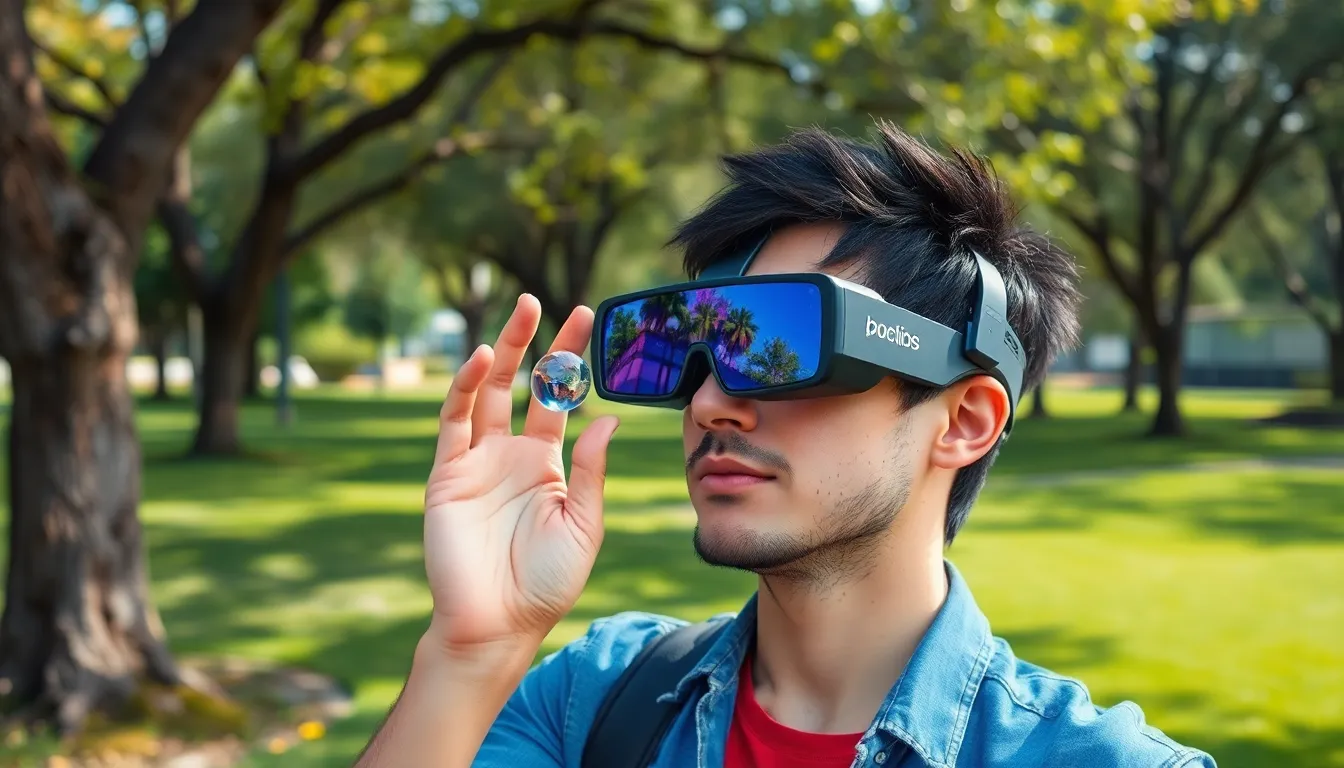Augmented reality isn’t just for sci-fi movies or that one friend who can’t stop playing Pokémon Go. It’s a game-changer, blending the digital world with our everyday lives in ways that are both fascinating and practical. Imagine walking through a museum and having a virtual tour guide pop up to share juicy tidbits about the exhibits—talk about a history lesson with flair!
In a world where the line between reality and digital is increasingly blurry, understanding augmented reality is more important than ever. Whether it’s enhancing shopping experiences or revolutionizing education, AR is here to stay. So buckle up as we dive into what augmented reality really means and how it’s transforming the way we see the world—one virtual layer at a time.
Table of Contents
ToggleWhat Is Augmented Reality?
Augmented reality (AR) enhances real-world environments by overlaying digital information onto physical objects and spaces. This technology enriches user experiences across various industries.
Brief History of Augmented Reality
AR’s origins trace back to the 1960s when computer scientist Ivan Sutherland created the first head-mounted display, known as the “Sword of Damocles.” In the 1990s, AR made strides in military training and medical visualization. Early 2000s innovations introduced mobile AR through applications like QR codes. Google Glass’s launch in 2013 marked a pivotal moment in commercial AR. Since then, devices and platforms have significantly evolved, leading to widespread consumer adoption in video games and social media.
Key Components of Augmented Reality
Multiple components create an effective AR experience. Hardware includes sensors, cameras, and displays that capture and project augmented visuals. Software provides the necessary algorithms and frameworks to process data and ensure real-time interaction. User interfaces integrate touch, gestures, and voice commands for intuitive navigation. Spatial mapping enables the accurate placement of virtual objects within physical spaces. These combined elements facilitate interactive experiences that blend seamlessly with the real world, enhancing various applications from shopping to education.
How Augmented Reality Works


Augmented reality blends digital elements with the real world, enhancing user experiences through advanced technology. This integration forms the foundation of AR’s functionality.
Technology Behind Augmented Reality
Key technologies enable augmented reality to function effectively. Sensors gather data from the environment, enabling accurate detection of physical spaces. Cameras capture images and video, essential for overlaying virtual content. Processors handle the data, ensuring smooth operation and interaction. Displays showcase the augmented visuals, creating an immersive experience. All these components work together to ensure seamless interaction between digital information and the physical world.
Types of Augmented Reality Systems
Several types of augmented reality systems exist, each designed for specific applications. Marker-based AR utilizes visual markers to trigger digital overlays, often seen in print media. Markerless AR relies on GPS and sensors to enhance user experiences without the need for physical markers. Projection-based AR projects digital content onto physical surfaces, enabling interaction with augmented visuals. Superimposition-based AR displays virtual objects in real-world contexts, enhancing applications from gaming to education. Each system serves unique purposes while enhancing user engagement through interactive experiences.
Applications of Augmented Reality
Augmented reality transforms how individuals interact with various sectors, creating immersive experiences.
Augmented Reality in Gaming
Gaming has significantly benefitted from augmented reality. Players engage with virtual elements that overlay their physical surroundings. Popular titles like Pokémon GO demonstrate AR’s potential, allowing users to capture virtual creatures in real-world locations. This blend of reality and simulation enhances user interaction, making gameplay more dynamic. Developers continue introducing innovative features, increasing player immersion and retention in the gaming community.
Augmented Reality in Education
Education also experiences a revolution through augmented reality. Students visualize complex concepts with interactive AR applications. Programs like Google Expeditions enable virtual field trips, allowing learners to explore various locations without leaving the classroom. Detailed 3D models offer hands-on experiences, facilitating deeper understanding of subjects like biology and history. This engagement fosters a more effective learning environment, encouraging students to grasp materials better.
Augmented Reality in Retail
Retailers increasingly adopt augmented reality to enhance shopping experiences. Customers can virtually try on clothing and accessories using AR apps, reducing the need for physical fitting rooms. Brands like IKEA utilize AR to let users visualize furniture in their homes before purchase. This capability streamlines decision-making, leading to higher customer satisfaction. Overall, retailers leverage AR to bridge the gap between online and in-store shopping, creating seamless experiences for consumers.
Benefits of Augmented Reality
Augmented reality (AR) offers numerous benefits that enhance various aspects of daily life and business operations.
Enhanced User Experience
Augmented reality enriches user experiences by providing interactive elements that blend seamlessly with the real world. Users access relevant information through visual overlays, enabling a deeper understanding of their surroundings. For example, AR in education allows students to explore 3D models of historical artifacts or complex scientific structures, providing a tangible context that traditional methods cannot match. Users appreciate this immersive approach, making learning more engaging and effective. Additionally, in retail environments, customers can visualize how products fit within their space, simplifying decision-making and enhancing satisfaction.
Increased Engagement
Increased engagement is a significant advantage of augmented reality across various applications. AR captures user attention and encourages prolonged interaction through dynamic content. For instance, in gaming, players experience a heightened sense of involvement as they interact with virtual elements in their physical spaces. This blend of reality and digital stimuli keeps players motivated to explore further. Furthermore, AR in marketing campaigns invites consumers to engage with brands through interactive advertisements, effectively increasing brand recognition and loyalty.
Challenges and Limitations of Augmented Reality
Augmented reality (AR) faces several challenges and limitations that impact its widespread adoption and functionality. These obstacles must be addressed to fully leverage AR’s potential across various sectors.
Technical Challenges
Technical issues hinder AR’s effectiveness and user experience. Limited battery life in devices restricts prolonged use, making extended applications challenging. Network connectivity can also affect performance. Poor or inconsistent internet connections lead to lag or interruptions in augmented experiences. Additionally, environmental factors, such as lighting and surface textures, influence the accuracy of object placement. AR systems often struggle to maintain stability in dynamic settings, which can disrupt user interactions. Hardware limitations, such as insufficient processing power in some devices, further complicate the delivery of seamless experiences. Without ongoing advancements in technology, these obstacles will persist.
Privacy Concerns
Privacy issues complicate the implementation of AR applications. Users often share personal data when engaging with AR systems, and that data can be susceptible to unauthorized access. Companies developing these technologies face scrutiny over how they collect and manage user information. Transparency about data usage becomes crucial for maintaining user trust. Surveillance capabilities embedded in AR devices may raise ethical questions regarding consent. When AR applications analyze real-world environments, they might unintentionally capture sensitive information, leading to potential breaches of privacy. Addressing these concerns requires robust policies to protect user data and ensure responsible use of technology.
Augmented reality is reshaping how individuals interact with their environments by merging digital information with the physical world. Its applications span various sectors including education gaming and retail enhancing experiences and engagement. As this technology continues to evolve it holds the potential to transform everyday life making interactions more immersive and informative.
While challenges such as technical limitations and privacy concerns remain AR’s benefits are substantial. With ongoing advancements and careful consideration of ethical implications AR is set to play a pivotal role in the future of technology enriching user experiences and redefining reality as we know it.






